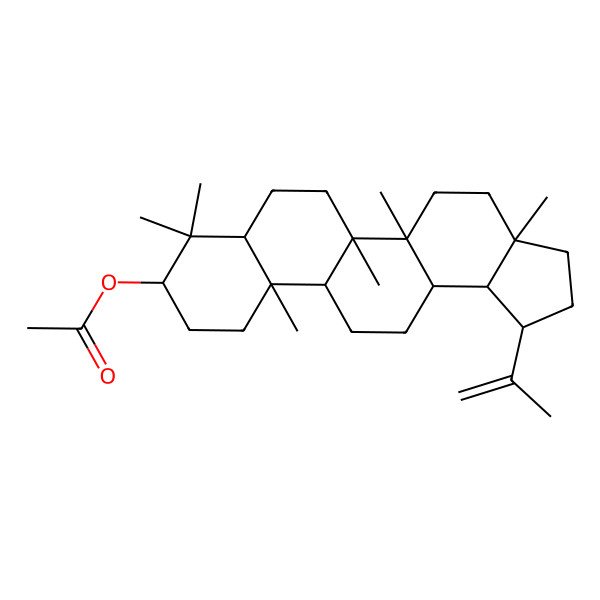Lup-20(29)-en-3beta-ol, acetate
| Internal ID | 614fc338-9eb1-468c-8b43-eb5fb465dd61 |
| Taxonomy | Lipids and lipid-like molecules > Prenol lipids > Triterpenoids |
| IUPAC Name | (3a,5a,5b,8,8,11a-hexamethyl-1-prop-1-en-2-yl-1,2,3,4,5,6,7,7a,9,10,11,11b,12,13,13a,13b-hexadecahydrocyclopenta[a]chrysen-9-yl) acetate |
| SMILES (Canonical) | CC(=C)C1CCC2(C1C3CCC4C5(CCC(C(C5CCC4(C3(CC2)C)C)(C)C)OC(=O)C)C)C |
| SMILES (Isomeric) | CC(=C)C1CCC2(C1C3CCC4C5(CCC(C(C5CCC4(C3(CC2)C)C)(C)C)OC(=O)C)C)C |
| InChI | InChI=1S/C32H52O2/c1-20(2)22-12-15-29(6)18-19-31(8)23(27(22)29)10-11-25-30(7)16-14-26(34-21(3)33)28(4,5)24(30)13-17-32(25,31)9/h22-27H,1,10-19H2,2-9H3 |
| InChI Key | ODSSDTBFHAYYMD-UHFFFAOYSA-N |
| Popularity | 1 reference in papers |
| Molecular Formula | C32H52O2 |
| Molecular Weight | 468.80 g/mol |
| Exact Mass | 468.396730897 g/mol |
| Topological Polar Surface Area (TPSA) | 26.30 Ų |
| XlogP | 10.40 |
| Lup-20(29)-en-3-yl acetate |
| 20(29)-Lupenol acetate |
| Lup-20(29)-en-3-ol, acetate, (3.beta.)- |
| Lupeol, acetate |
| Lup-20(29)-en-3-yl acetate # |
| NSC-281806 |
| 3-(Dodecanoylamino)benzoicacid |
| DTXSID70936584 |
| ODSSDTBFHAYYMD-UHFFFAOYSA-N |
| NSC281806 |
| There are more than 10 synonyms. If you wish to see them all click here. |

| Target | Value | Probability (raw) | Probability (%) |
|---|---|---|---|
| No predicted properties yet! | |||
Proven Targets:
| CHEMBL ID | UniProt ID | Name | Min activity | Assay type | Source |
|---|---|---|---|---|---|
| No proven targets yet! | |||||
Predicted Targets (via Super-PRED):
| CHEMBL ID | UniProt ID | Name | Probability | Model accuracy |
|---|---|---|---|---|
| CHEMBL4203 | Q9HAZ1 | Dual specificity protein kinase CLK4 | 96.08% | 94.45% |
| CHEMBL3251 | P19838 | Nuclear factor NF-kappa-B p105 subunit | 94.90% | 96.09% |
| CHEMBL241 | Q14432 | Phosphodiesterase 3A | 92.72% | 92.94% |
| CHEMBL4026 | P40763 | Signal transducer and activator of transcription 3 | 91.38% | 82.69% |
| CHEMBL340 | P08684 | Cytochrome P450 3A4 | 88.70% | 91.19% |
| CHEMBL253 | P34972 | Cannabinoid CB2 receptor | 88.54% | 97.25% |
| CHEMBL4685 | P14902 | Indoleamine 2,3-dioxygenase | 88.37% | 96.38% |
| CHEMBL1966 | Q02127 | Dihydroorotate dehydrogenase | 86.13% | 96.09% |
| CHEMBL233 | P35372 | Mu opioid receptor | 85.14% | 97.93% |
| CHEMBL2581 | P07339 | Cathepsin D | 85.06% | 98.95% |
| CHEMBL1994 | P08235 | Mineralocorticoid receptor | 82.42% | 100.00% |
| CHEMBL2373 | P21730 | C5a anaphylatoxin chemotactic receptor | 82.19% | 92.62% |
| CHEMBL1293316 | Q9HBX9 | Relaxin receptor 1 | 82.10% | 82.50% |
| CHEMBL5608 | Q16288 | NT-3 growth factor receptor | 81.85% | 95.89% |
| CHEMBL2274 | Q9H228 | Sphingosine 1-phosphate receptor Edg-8 | 81.28% | 100.00% |
| CHEMBL218 | P21554 | Cannabinoid CB1 receptor | 80.90% | 96.61% |
| CHEMBL4793 | Q86TI2 | Dipeptidyl peptidase IX | 80.60% | 96.95% |
| CHEMBL3351 | Q13085 | Acetyl-CoA carboxylase 1 | 80.38% | 93.04% |
| CHEMBL3137262 | O60341 | LSD1/CoREST complex | 80.38% | 97.09% |
| CHEMBL1907601 | P11802 | Cyclin-dependent kinase 4/cyclin D1 | 80.26% | 98.99% |
Below are displayed all the plants proven (via scientific papers) to contain this
compound!
To see more specific details click the taxa you are interested in.
To see more specific details click the taxa you are interested in.
| PubChem | 323074 |
| LOTUS | LTS0081577 |
| wikiData | Q104193276 |